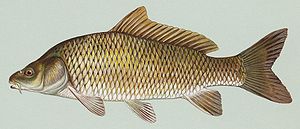Cyprinus
| Cyprinus | ||||||||||||
|---|---|---|---|---|---|---|---|---|---|---|---|---|

Common carp |
||||||||||||
| Systematics | ||||||||||||
|
||||||||||||
| Scientific name | ||||||||||||
| Cyprinus | ||||||||||||
| Linnaeus , 1758 |
Cyprinus is a genus of carp fish . The name is derived from "Kyprinos" or "Kyprianos", the name Aristotle gave to the carp , which he probably named after an epithet of Aphrodite (Kypris)because of its fertility. The distribution area of the genus includes Europe and Asia Minor as well as the continental East and parts of Southeast Asia . However, Cyprinus species were introduced in many places and can therefore now also be found outside of their original settlement area. In particular, the type species Cyprinus carpio and its domesticated forms are considered to be particularly invasive and pose a threat to autochthonous species in some areas of introduction.
features
They are typical representatives of their family with a moderately elongated to high-backed body that is slightly flattened on the sides. The terminal mouth has clear lips and can be extended forward. There are usually two pairs of barbels . The eyes are either on or above the body axis. Three to four hard and eleven to 22 soft rays support the elongated dorsal fin . The last hard beam is serrated backwards. The anal fin is short and has an undivided soft ray with a saw profile on the back and five to six divided soft rays. The caudal fin is clearly notched . 26 to 45 of the large scales sit along the full sideline . The three rows of pharyngeal teeth are predominantly in the arrangement 1,1,3 - 3,1,1, rarely 1,2,3 - 3,2,1.
Systematics
The internal systematics of the genus is very controversial and the number of recognized subgenera and species is subject to frequent changes. For example, the number of species recognized in southern China varies between nine and thirteen, depending on the number of subspecies recognized by the respective author. The possibility that some of these species are feral forms of domesticated cyprinus species has been raised, as has the hypothesis that these species are the result of an adaptive process in southern China and the surrounding areas.
- Cyprinus acutidorsalis Wang, 1979
- Cyprinus bajiangensi Li, 2019
- Cyprinus barbatus Chen & Huang, 1977
- Common carp ( Cyprinus carpio ) Linnaeus, 1758
- Cyprinus centralus Nguyen & Mai, 1994
- Cyprinus chilia Wu, Yang & Huang in Wu, Yang, Yue & Huang, 1963
- Cyprinus cocsa Hamilton, 1822
- Cyprinus dai (Nguyen & Doan, 1969)
- Cyprinus daliensis Chen & Huang, 1977
- Cyprinus exophthalmus May, 1978
- Cyprinus fuxianensis Yang et al. in Chen & Huang, 1977
- Cyprinus hyperdorsalis Nguyen, 1991
- Cyprinus ilishaestomus Chen & Huang, 1977
- Cyprinus intha Annandale, 1918
- Cyprinus longipectoralis Chen & Huang, 1977
- Cyprinus longzhouensis Yang & Hwang in Chen & Huang, 1977
- Cyprinus megalophthalmus Wu et al., 1963
- Cyprinus micristius Regan, 1906
- Cyprinus multitaeniata Pellegrin & Chevey, 1936
- Cyprinus pellegrini Tchang, 1933
- Cyprinus qionghaiensis Liu, 1981
- Cyprinus rubrofuscus Lacepède, 1803
- Cyprinus yilongensis Yang et al. in Chen & Huang, 1977
- Cyprinus yunnanensis Tchang, 1933
supporting documents
- ↑ Axel Zarske: Cyprinus. In: Claus Schaefer, Torsten Schröer (Hrsg.): The large lexicon of aquaristics. Eugen Ulmer, Stuttgart 2004, ISBN 3-8001-7497-9 , p. 316.
- ^ Petru M. Bănărescu, Hans-Joachim Paepke: The Freshwater Fishes of Europe. (Volume 5.Cyprinidae 2 part III: Carassius to Cyprinus ; Gastorosteidae) Aula-Verlag, Wiebelsheim 2002, ISBN 3-89104-658-8 , p. 87
- ^ Petru M. Bănărescu, Hans-Joachim Paepke: The Freshwater Fishes of Europe. (Volume 5.Cyprinidae 2 part III: Carassius to Cyprinus ; Gastorosteidae) Aula-Verlag, Wiebelsheim 2002, ISBN 3-89104-658-8 , p. 83.
- ↑ 100 of the World's Worst Invasive Alien Species, No. 30. In: Global Invasive Species Database. issg.org, accessed May 14, 2015 .
- ↑ a b Günther Sterba: Freshwater fish of the world. Weltbild Verlag, Augsburg 1998, ISBN 3-89350-991-7 , p. 275.
- ^ A b c Petru M. Bănărescu, Hans-Joachim Paepke: The Freshwater Fishes of Europe. (Volume 5.Cyprinidae 2 Part III: Carassius to Cyprinus ; Gastorosteidae) Aula-Verlag, Wiebelsheim 2002, ISBN 3-89104-658-8 , p. 79 ff.
- ↑ Species list by itis.gov.
Web links
- Cyprinus on Fishbase.org (English)